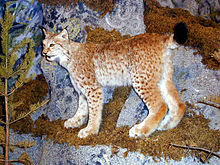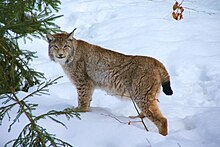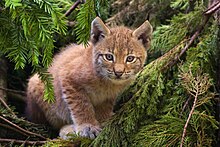
Taxonomy
Northern lynx (Lynx lynx lynx), mounted
- Northern lynx (L. l. lynx) Linnaeus, 1758: Fennoscandia, Baltic states, Poland, Belarus, European part of eastern, western, northern, central part of Russia, Ural Mountains, Western Siberia east to the Yenisei river[2]
- Turkestan lynx (L. l. isabellinus) Blyth, 1847: Central Asia
- Caucasian lynx (L. l. dinniki) Satunin, 1915: Caucasus
- Siberian lynx (L. l. wrangeli) Ognew, 1928: Eastern Siberia
- Balkan lynx (L. l. balcanicus) Bures, 1941: Balkans
- Carpathian lynx (L. l. carpathicus) Kratochvil & Stollmann, 1963: Carpathian Mountains, Central Europe
- Altai lynx (L. l. wardi) Lydekker, 1904: Altai Mountains
- Baikal lynx (L. l. kozlovi) Fetisov, 1950: Central Siberia
- Amur lynx (L. l. stroganovi) Heptner, 1969: Amur region
Characteristics
Skull, as illustrated by N. N. Kondakov
Distribution and habitat
Eurasian lynx in profile
Europe
The Eurasian lynx was once quite common in most of continental Europe. By the early 19th century, it was persecuted to local extinction in western and southern European lowlands, but survived only in mountainous areas and Scandinavian forests. By the 1950s, it had become extinct in most of Western and Central Europe, where only scattered and isolated populations exist today.[9]The Eurasian lynx was close to extinction in Scandinavia in the 1930s. Since the 1950s, the population slowly recovered and forms three subpopulations in northern, central and southern Scandinavia.[10] In Norway, the Eurasian lynx was subjected to an official bounty between 1846 and 1980 and could be hunted without license. In 1994, a compensation scheme for livestock killed by lynx was introduced. By 1996, the lynx population was estimated to comprise 410 Individuals, decreased to less than 260 individuals in 2004 and increased since 2005 to about 452 mature individuals by 2008.[11] In Sweden, the lynx population was estimated at about 1,400 individuals in 2006 and 1,250 in 2011. Hunting is controlled by government agencies.[12] In Finland, about 2,200–2,300 individuals were present according to a 2009 estimate.[13] Lynx population in Finland have been increasing every year since 1991, and is estimated to be nowadays larger than ever before. Limited hunting is permitted. In 2009 the Finnish Ministry of Agriculture and Forestry gave a permit for hunting of 340 lynx individuals.[14]
Western Europe
Lynx in the Bavarian Forest National Park, Germany
In Germany, the Eurasian lynx was exterminated in Germany in 1850. It was reintroduced to the Bavarian Forest and the Harz in the 1990s; other areas were populated by lynx immigrating from neighboring France and the Czech Republic. In 2002 the first birth of wild lynx on German territory was announced, following a litter from a pair of lynx in the Harz National Park. Small populations exist also in Saxon Switzerland, Palatinate Forest, and Fichtelgebirge. Eurasian lynx also migrated to Austria, where they had also been exterminated. An episode of the PBS television series Nature featured the return of the lynx to Austria's Kalkalpen National Park after a 150-year absence.[19] A higher proportion are killed by human causes than by infectious diseases.[20] In the United Kingdom, the Eurasian lynx is extirpated since the Middle Ages. It was proposed to reintroduce the species to the Scottish Highlands.[21][22]
Eastern Europe
- Carpathian Mountains: About 2,800 Eurasian lynx live in this mountain range in the Czech Republic, Poland, Romania, Slovakia, Bosnia and Herzegovina and Hungary.[23] It is the largest contiguous Eurasian Lynx population west of the Russian border.
- Czech Republic: In Bohemia, the Eurasian lynx was exterminated in the 19th century (1830–1890) and in Moravia probably at the turn of the 20th century. After 1945, migration from Slovakia created a small and unstable population in Moravia. In the 1980s, almost 20 specimens were imported from Slovakia and reintroduced in the Šumava area. In early 2006, the population of lynx in the Czech Republic was estimated at 65–105 individuals. Hunting is prohibited, but the lynx is often threatened by poachers.
- Poland: In its Environment and Environmental Protection Section, the 2011 Central Statistical Office Report puts the number of Eurasian lynxes observed in the wild in Poland as of 2010 at approximately 285.[24] There are two major populations of lynxes in Poland, one in the northeastern part of the country (most notably in the Białowieża Forest) and the other in the southeastern part in the Carpathian Mountains. Since the 1980s, lynxes have also been spotted in the region of Roztocze, Solska Forest, Polesie Lubelskie, and Karkonosze Mountains, though they still remain rare in those areas. A successfully reintroducted population of lynxes has also been living in the Kampinos National Park since the 1990s.[citation needed]
- Slovakia: the Eurasian lynx inhabits deciduous, coniferous and mixed forests at elevations of 180–1,592 m (591–5,223 ft) in Štiavnica Mountains and Veľká Fatra National Park. Surveys during 2011 to 2014 revealed that less than 30 individuals live in these protected areas.[25]
- Estonia: There are 900 individuals in Estonia according to a 2001 estimate.[26] Although 180 lynx were legally hunted in Estonia in 2010, the country still has the highest known density of the species in Europe.[27]
- Latvia: According to a 2005 estimate, about 700 animals inhabit areas in Courland and Vidzeme.[28]
- Lithuania: The population is estimated at 80–100 animals.[29]
- Russia: As of 2013, the Russian lynx population is estimated as comprising 22,510 individuals and is considered abundant and stable in some regions.[2]
- Balkan peninsula: The Balkan lynx subspecies is found in Croatia, Montenegro, Albania, Kosovo, North Macedonia, Bulgaria and possibly Greece.[30][need quotation to verify] They can be found in remote mountainous regions of the Balkans, with the largest numbers in remote hills of western North Macedonia, eastern Albania and northern Albania. The Balkan Lynx is considered a national symbol of North Macedonia,[31] and it is depicted on the reverse of the Macedonian 5 denars coin, issued in 1993.[32] The name of Lynkestis, a Macedonian tribe, is translated as "Land of the Lynx". It has been on the brink of extinction for nearly 100 years. Numbers are estimated to be around 100, and the decline is due to illegal poaching.[33][34]
- Dinaric Alps and Julian Alps: Slovenia, Croatia, and Bosnia and Herzegovina are home to approx. 130–200 lynx.[23][35] The Eurasian lynx had been considered extinct in these countries since the beginning of the 20th century. However, a successful reintroduction project was carried out in Slovenia in 1973, when three female and three male lynx from Slovakia were released in the Kočevski Rog forest.[36] Today, lynx are present in the Dinaric forests of the south and southeastern part of Slovenia and in the Croatian regions of Gorski kotar and Velebit, spanning the Dinaric Alps and over the Dinara Mountains into western Bosnia and Herzegovina. The lynx has been also spotted in the Julian Alps and elsewhere in western Slovenia, but the A1 motorway presents a significant hindrance to the development of the population there.[37] Croatia's Plitvice Lakes National Park is home to several pairs of the lynx. In the three countries, the Eurasian lynx is listed as an endangered species and protected by law. Realistic population estimates are 40 lynx in Slovenia, 40–60 in Croatia, and more than 50 in Bosnia and Herzegovina. The Croatian massif Risnjak in Risnjak National Park probably got its name from the Croatian word for the lynx, ris.
- Hungary: The population is estimated at 10-12 animals, in the northern mountain ranges of the country close to Slovakia.[citation needed]
- Romania: over 2,000 Eurasian lynx live in Romania, including most of the Carpathian population. However, some experts consider these official population numbers to be overestimated.[38] Limited hunting is permitted but the population is stable.
- Bulgaria: the animal was declared extinct in Bulgaria in 1985, but sightings continued well into the 1990s. In 2006 an audio recording of a lynx mating call was made in the Strandzha mountain range in the southeast. Two years later an ear-marked individual was accidentally shot near Belogradchik in the northwest, and a few months later a mounted trap camera caught a glimpse of another individual. Further camera sightings followed in Osogovo as well as Strandzha, confirming that the animal has returned to the country. A thorough examination on the subject is yet to be made available.
- Ukraine: The Eurasian lynx is native to forested areas of the country. Before the 19th century it was common also in the forest steppe zone. Nowadays, the most significant populations remain in the Carpathian mountains and across the forests of Polesia. The population is estimated as 80–90 animals for the Polesia region and 350–400 for the forests of the Carpathians.[39]
Asia
Anatolia and Caucasus
In the Anatolian part of Turkey, the Eurasian lynx is present in the Lesser Caucasus, Kaçkar Mountains and Artvin Province.[40][41] In Ciglikara Nature Reserve located in the Taurus Mountains, 15 individuals were identified.[42] More than 50 individuals were identified and monitored at a forest-steppe mixed ecosystem in northwestern Anatolia by camera traps, genetic material and radiotelemetry between 2009 and 2019.[43][44] In Kars Province, a breeding population occurs in Sarıkamış-Allahuekber Mountains National Park.[45] Eurasian lynx and grey wolf can occur sympatrically, as they occupy different trophic niches.[46][47]Central Asia
In Central Asia, it is native to Kazakhstan, Uzbekistan, Turkmenistan, Kyrgyzstan, Tajikistan, Afghanistan and the Chinese provinces of Xinjiang, Gansu, Qinghai, Sichuan, and Shaanxi, as well as to the northern slopes of Iran's Alborz Mountains, Mongolia.[citation needed]In northern Pakistan, the Eurasian lynx was recorded at elevations of 1,067–5,000 m (3,501–16,404 ft) in Chitral District.[48][49] In India: Ladakh, Himachal Pradesh and most other Himalayan states.
In Nepal, a Eurasian lynx was sighted in the western Dhaulagiri massif in 1975.[50] It is also present above elevations of 3,800 m (12,500 ft) in Humla, Mustang and Dolpa Districts.[51]
Fossils of the Eurasian or a closely related Lynx species from the Late Pleistocene era and onward were excavated at various locations in the Japanese archipelago. Since no archaeological evidence after the Yayoi period was found, it was probably eradicated during the Jōmon period.[52]
Behaviour and ecology
Eurasian lynx
Diet and hunting
Diet in Europe
Eurasian lynx in Europe, prey largely on small to fairly large sized mammals and birds. Among the recorded prey items for the species are hares, rabbits, marmots, squirrels, dormice, other rodents, mustelids (such as martens), grouse, red foxes, wild boar, chamois, young moose, roe deer, red deer, reindeer and other ungulates. Although taking on larger prey presents a risk to the animal, the bounty provided by killing them can outweigh the risks. The Eurasian lynx thus prefers fairly large ungulate prey, especially during winter when small prey is less abundant. Where common, roe deer appear to be the preferred prey species for the lynx.[54][55] Even where roe deer are quite uncommon, the deer are still quantitatively the favored prey species, though in summer smaller prey and occasional domestic sheep are eaten more regularly.[56] In parts of Finland, introduced white-tailed deer are eaten regularly. In some areas in Poland and Austria, red deer is the preferred prey, and in Switzerland, chamois is locally favored.[55] Eurasian lynx also feeds on carrion when available. Adult lynx require 1.1 to 2 kilograms (2.4 to 4.4 lb) of meat per day, and may take several days to fully consume some of their larger prey.[6]Diet in Asia
In the Mediterranean mixed forest-steppe and subalpine ecosystems of Anatolia the main and most preferred prey of the Eurasian lynx is European hare, forming 79% to 99% of prey biomass eaten. Although the lynx is in sympatry with wild ungulates, such as wild goat, chamois, red deer and wild boar in these ecosystems, ungulate biomass in lynx diet does not exceed 10%.[46] In ten other study sites in the Black Sea region of northern Anatolia where roe deer can occur in high densities, lynx occurrence is positively correlated with European hare occurrence rather than roe deer.[57] Lynx in Anatolia also has physiological requirements and morphological adjustments similar to other lagomorph specialists, with a daily prey intake of about 900 g (32 oz).[46] It is therefore classified as lagomorph specialist. Diet studies in central [58][59] and northern Asia also indicate a diet mainly composed of lagomorphs and ungulate prey contributes in low amounts to lynx diet.[60]Hunting
The main method of hunting is stalking, sneaking and jumping on prey, although they are also ambush predators when conditions are suitable. In winter certain snow conditions make this harder and the animal may be forced to switch to larger prey in Europe. Eurasian lynx hunt using both vision and hearing, and often climb onto high rocks or fallen trees to scan the surrounding area. A very powerful predator, these lynxes have successfully killed adult deer weighing to at least 150 kg (330 lb).[61]Predators
In Russian forests, the most important predators of the Eurasian lynx are the grey wolf. Wolves kill and eat lynxes that fail to escape into trees. Lynx populations decrease when wolves appear in a region and are likely to take smaller prey where wolves are active.Wolverines are perhaps the most dogged of competitors for kills, often stealing lynx kills. Lynxes tend to actively avoid encounters with wolverines, but may sometimes fight them if defending kittens. Instances of predation on lynx by wolverines may occur, even perhaps on adults, but unlike wolf attacks on lynx are extremely rare if they do in fact occur. There are no known instances of lynx preying on a wolverine.
In two ecosystems of Anatolia, cannibalism was common and lynx found to form 5% to 8% of prey biomass in diet. Claws and bones analysed showed that sub-adult lynx were the victims of cannibalism during the mating and spring seasons.[46] Lynx were not found in the sympatrically occurring wolves' diet,[47] however, lynx itself was the predator of golden jackal, red fox, martens, domestic cat and dog.[46] Sometimes, Siberian tigers have also preyed on lynxes, as evidenced by examination of tiger stomach contents.[8][62] In Sweden, out of 33 deaths of lynx of a population being observed, one was probably killed by a wolverine.[63][64] Lynx compete for food with the predators described above, and also with the red fox, eagle owls, golden eagles, wild boar (which scavenge from lynx kills), and in the southern part of its range, the snow leopard and leopard as well.[8] Brown bears, although not (so far as is known) a predator of Eurasian lynx, are in some areas a semi-habitual usurpers of ungulate kills by lynxes, not infrequently before the cat has had a chance to consume its kill itself.[65][55]
Reproduction
Eurasian lynx kitten
Conservation
Eurasian lynx at the Zoo Aquarium de Madrid







No comments:
Post a Comment
Note: Only a member of this blog may post a comment.